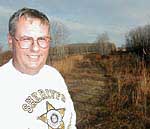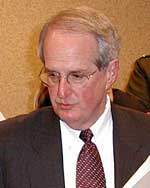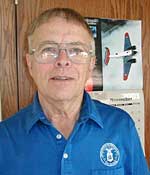By Bob Reha
Minnesota Public Radio
December 17, 2001
|
| RealAudio |
America's border with Canada has always been open. Friendly relations between the two countries have meant it's been easy to travel between the two nations. The September terrorist attacks have increased the fear factor on the border, and created momentum for improving security. Congress is moving forward with plans to upgrade the resources used to guard the 4,000-mile stretch of border between the two countries. But until those promises become reality, who is protecting our northern border?
| |
|
|
|
||
There are more than 100 ports of entry along the U.S.-Canadian border - places where the federal government has staff to process visitors traveling from Canada. They are busy places.
"A half a million people come over the northern border every day," says James Ziglar, commissioner of the U.S. Immigration and Naturalization Service.
"And over $1 billion of commerce comes over the northern border every day. It is a huge task, and we've got 965 people up here."
That's roughly one INS person for every four miles of border. The Border Patrol won't reveal the number of agents it has on the northern border, but it's not much more.
Since Sept. 11, border security has been increased, and federal officials have back-up. State agencies and militias have picked up some of the duties. Civilian volunteers, such as the Civil Air Patrol, have also stepped up.
The Civil Air Patrol is an auxiliary branch of the U.S. Air Force, but all members are unpaid volunteers.
"Who don't have any guns or rockets on board their airplanes," says Walt Vollmers, vice commander for the North Dakota Civil Air Patrol.
The Fargo squadron of the Civil Air Patrol has six planes stationed across the state. In October, wing members flew more than 100 hours of missions along the border. The patrol has no enforcement power. Vollmers says their role is limited strictly to reconnaissance.
"But it does heighten the the vigilance. "Before Sept. 11, well, there was very little vigilance," says Vollmers.
Civil Air Patrol members come from all walks of life. Vollmers is a retired professor who loves to fly. Another member, Jay Manley, works for a software company. Manley says the CAP's primary mission is search and rescue.
| |
|
|
|
||
Members are trained to observe - to look for things out of the ordinary or unusual. They're also adept at guiding law enforcement officials on the ground to exact locations. Manley says even though CAP members are volunteers, they take their work very seriously, especially since Sept. 11.
"It took a whole new meaning about our mission. I was really cognizant of it when we were in the air the first time," Manley says. "It was like, 'This really makes a difference. This is something that's different than it has been in the past."
Manley says since the attacks, pilots and observers pay a little closer attention to things like tracks in the snow. He says nothing unusual goes unreported.
"Some of the activities that we have found are things like a pickup with one bumper parked in Canada and one bumper parked in the United States. (The driver is) obviously out there not doing what he's supposed to be doing, so we'll call the sheriff and report that incident," Manley says.
CAP members say being able to fly, or serve as an observer on border patrols, gives them a sense that they're contributing to the defense of the country.
Patrolling the border is nothing new for Kittson County Sheriff Ray Hunt. Hunt says Kittson County and Canada share 35 miles of border. Most of it is isolated brush and timber. While it might seem simple to slip across the border undetected, Sheriff Hunt says the rough country can be a deterrent. He recalls at least one case where nature helped apprehend suspects who crossed into the country illegally.
"The mosquitos were so God-awful bad that those poor devils were bit from one end to the other," says Hunt. "We finally caught them right in town."
Hunt and his four deputies assist the Border Patrol and Customs officials.
"We help the port with drug seizures, and we charge them out locally. We help them with run-throughs where we can," says Hunt. "Because we're so small we don't always have people in position to do it, but we always try to assist them if we can."
| |
|
|
|
||
Hunt says local officials have also take action to secure the border. One example is a back road that was internationally-known as a route into the country. The dirt road crossed the border where there was no checkpoint.
"This is Canada. We're standing right on the border," he says. Seven years ago, Hunt says, officials decided the road would be closed.
"(They) trenched this out and dead-ended it - put a dead-end marker on either side -then put those cement pillars in. By and large it's kept people out."
Hunt concedes it is still relatively easy to cross here on foot. But he says actions like this have helped slow illegal crossings. Hunt says the biggest challenge in securing the border is getting enough trained people in the field. When you talk to locals, like Hallock City Clerk Hank Noel, they feel safe.
"In fact when we've visited about it, people feel like there's actually more security there. If anything, it's more safe than we were before it," says Noel.
Immigration and Naturalization Service Commissioner James Zigler announced recently 100 new agents were being assigned to the northern border, and more are on the way. Congress has also passed legislation to spend $28 million to strengthen border security. U.S. Sen. Byron Dorgan, D-N.D., wrote the legislation. He says it will fund additional personnel and equipment.
"It will include money for inspectors and canine enforcement officers, special agents and so on," Dorgan says. "This is a down payment on the needs for the northern border."
Dorgan says it could be months before the personnel start appearing at entry ports across the north. Until then, groups like the Civil Air Patrol and local law enforcement officials will continue to pick up the slack.



